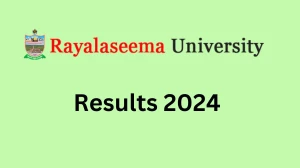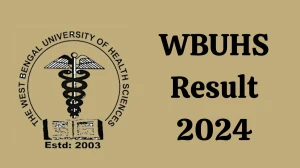- Rojgarlive »
- Education »
- SRMJEEE Syllabus 2024 srmist.edu.in Download Pdf SRMJEEE Syllabus
SRMJEEE Syllabus 2024 srmist.edu.in Download Pdf SRMJEEE Syllabus
by Sangeetha
Updated Apr 23, 2024

SRMJEEE Syllabus 2024 @ srmist.edu.in
SRM Institute of Science and Technology (SRMIST) has recently unveiled the comprehensive syllabus for SRMJEEE 2024 on its official website, srmist.edu. The syllabus details for SRMJEE 2024 are outlined in the information brochure provided by the authorities.
Interested candidates can access the official SRMJEEE 2024 syllabus in PDF format directly from the designated page. The SRMJEE syllabus encompasses key topics from Physics, Chemistry, and Mathematics, all of which will be evaluated in the SRMJEE examination.
Check - SRMJEEE Syllabus 2024
SRMJEEE 2024 Physics Syllabus
|
Units |
Topics Covered |
|
Units and Measurement, Mechanics |
Units for measurement, a system of units-S.I., fundamental and derived units, measurements - errors in measurement - significant figures, dimensions - dimensional analysis - applications. Laws of Motion: Newton’s laws of motion - force and inertia - impulse and momentum - law of conservation of linear momentum - applications - projectile motion uniform circular motion -friction - laws of friction - applications - centripetal force. Work, Energy, and Power: Work - energy - potential energy and kinetic energy – power - collision-elastic and inelastic collisions. |
|
Gravitation, Mechanics of Solids and Fluids
|
Gravitation: The universal law of gravitation, acceleration due to gravity - variation of ‘g’ with altitude, latitude, and depth - gravitation potential - escape velocity and orbital velocity - geostationary satellites - Kepler’s laws of planetary motion. Mechanics of solids and fluids: Solids - elastic behavior, stress-strain - Hooke’s law - Modulli of elasticity -relation between them - surface tension capillarity - applications – viscosity - Poiseuille’s formula - Stokes law applications - streamline and turbulent flow - Reynolds number - Bernoulli’s theorem - applications. |
|
Electrostatics |
Electric charge - Conservation laws - Coulomb’s principle of superposition - continuous charge distribution - electric field - electric field lines - electric dipole -electric field due to a dipole - torque on a dipole in a uniform electric field - Electric flux - Gauss’s theorem - field due to infinitely long straight wire - uniformly charged infinite plane sheet and uniformly charged thin spherical shell.
Electric potential - potential difference - equipotential surfaces - electrical potential energy - Dielectrics and electric polarization - capacitors and capacitance - combination of capacitors in series and in parallel - capacitance of a parallel plate capacitor with and without dielectric medium - energy stored in a capacitor. |
|
Current Electricity |
Electric current - drift velocity - mobility - Ohm’s law -V-I characteristics - electrical energy and power - electrical resistivity and conductivity - Carbon resistors - series and parallel combinations of resistors - temperature dependence - Internal resistance of a cell - potential difference and emf of a cell - combination of cells in series and in parallel - Kirchhoff’s laws – applications - Wheatstone bridge - Metre bridge - Potentiometer - comparison of EMF of two cells - measurement of internal resistance of a cell. |
SRMJEEE Chemistry Syllabus 2024
|
Units |
Topics Covered |
|
Solutions |
Types of solutions, expression of concentration of solutions of solids in liquids, solubility of gases in liquids, solid solutions, colligative properties - relative lowering of vapour pressure, Raoult’s law, elevation of boiling point, depression of freezing point, osmotic pressure, determination of molecular masses using colligative properties, abnormal molecular mass, Van’t Hoff factor. |
|
Electrochemistry |
Redox reactions, conductance in electrolytic solutions, specific and molar conductivity, variations of conductivity with concentration, Kohlrausch’s Law, electrolysis and law of electrolysis (elementary idea), dry cell-electrolytic cells and Galvanic cells, EMF of a cell, standard electrode potential, Nernst equation and its application to chemical cells, Relation between Gibbs energy change and EMF of a cell, fuel cells, corrosion. |
|
Chemical Kinetics |
Rate of a reaction (Average and instantaneous), factors affecting rate of reaction: concentration, temperature, catalyst; order and molecularity of a reaction, rate law and specific rate constant, integrated rate equations and half-life (only for zero and first order reactions), concept of collision theory (elementary idea, no mathematical treatment). Activation energy, Arrhenius equation. |
|
Surface Chemistry |
Adsorption - physisorption and chemisorption, factors affecting adsorption of gases on solids, catalysis, homogenous and heterogenous activity and selectivity; enzyme catalysis colloidal state distinction between true solutions, colloids and suspension; lyophilic, lyophobic multi-molecular and macromolecular colloids; properties of colloids; Tyndall effect, Brownian movement, electrophoresis, coagulation, emulsion - types of emulsions. |
SRMJEEE Mathematics Syllabus 2024
|
Units |
Topics Covered |
|
Sets, Relations, and Functions |
Sets and their representations, union, intersection, and complements of sets and their algebraic properties, relations, equivalence relations, mappings, one-one, into and onto mappings, and composition of mappings. |
|
Complex Numbers and Quadratic Equations
|
Complex numbers in the form a+ib and their representation in a plane. Argand diagram. Algebra of complex numbers, modulus and argument of a complex number, square root of a complex number. Cube roots of unity, triangle inequality. Quadratic equations in real and complex number system and their solutions. Relation between roots and coefficients, nature of roots, formation of quadratic equations with given roots; symmetric functions of roots, equations reducible to quadratic equations. |
|
Matrices, Determinants and Their Applications
|
Determinants and matrices of order two and three, properties of determinants, evaluation of determinants 14 Addition and multiplication of matrices, adjoint and inverse of matrix. Computing the rank of a matrix– test of consistency and solution of simultaneous linear equations using determinants and matrices |
SRMJEEE 2024 Syllabus for Biology
|
Units |
Topics Covered |
|
Diversity in the Living World |
Biodiversity, Importance of classifications, Taxonomy & Systematics, Concept of species and taxonomical hierarchy, Binomial nomenclature, Tools for study of Taxonomy. Five kingdom classifications: Monera, Protista, and Fungi into major groups; Lichens; Viruses and Viroids. Salient features of them. Classification of plants into major groups - Algae, Bryophytes, Pteridophytes, Gymnosperm and Angiosperm - salient and distinguishing features. Angiosperms - classification up to class, characteristic features and examples. Classification of animals- nonchordate up to phyla level and chordate up to classes level - salient and distinguishing features. |
|
Structural Organization in Animals and Plants
|
Plant tissues: Morphology and modifications, Tissues, Anatomy, and functions of different parts of flowering plants: Root, stem, leaf, inflorescence, flower, fruit and seed. Animal tissues: Morphology, anatomy, and functions of different systems (digestive, circulatory, Respiratory, nervous and reproductive) of an insect (cockroach) |
|
Cell Structure and Function |
Cell theory, Structure of prokaryotic and eukaryotic cells, Plant cell, and animal cell. Cell envelope, cell membrane, cell wall. Cell organelles - structure and function: Endomembrane system- endoplasmic reticulum, Golgi bodies, lysosomes, vacuoles, mitochondria, ribosomes, plastids, microbodies: Cytoskeleton, cilia, flagella, centrioles. Nucleus – nuclear membrane, chromatin, nucleolus. Chemical constituents of living cells: Biomolecules – structure and function of proteins including Enzymes– types, properties, enzyme action, carbohydrates, lipid and nucleic acids. Cell division: Cell cycle, mitosis, meiosis, and their significance. |
SRMJEEE Syllabus 2024 - FAQs
The concerned authorities of SRM Institute of Science and Technology has released the SRMJEEE syllabus 2024 on the official website.
Yes, the authorities have released the syllabus of SRMJEEE 2024.









